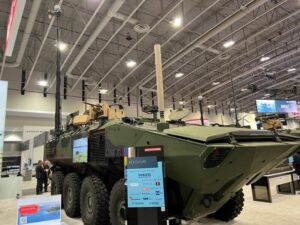BAE Systems anticipates the Marine Corps may decide how it will move ahead on its Advanced Reconnaissance Vehicle (ARV) program by late summer, a company official told reporters on Monday.
The Marine Corps is currently evaluating a version of BAE Systems’ Amphibious Combat Vehicle (ACV) integrated with a suite of C4/UAS capabilities as well two competitive prototypes from
General Dynamics Land Systems [GD] and Textron Systems [TXT] as it charts a path forward for the ARV effort.

“All of our information is going to feed that, just like the competitive prototyping is providing data to support [that]. It’s a very unique program. It’s kind of a dual path [effort]. You have the competitive prototypes and then the ACV competed well in the analysis of alternatives, so the Marine Corps wanted to carry that forward and not dismiss it as an option. So all the things we’ve integrated on it and all the testing we’ve done is to provide additional data…to enable [the Marine Corps] to make a more informed decision,” Mark Brinkman, BAE Systems’ director for advanced reconnaissance vehicles, said during a briefing at the Navy League’s Sea Air Space conference in National Harbor, Maryland on Monday.
The Marine Corps previously tasked BAE Systems with integrating a suite of C4/UAS capabilities onto an ACV, which the company currently builds for the service, with Brinkman noting that “prototype systems integration lab” is currently going through testing at Camp Pendleton in California to inform if such a platform could meet the ARV mission requirements.
“We took all of the transformational capabilities that would make up that unique [C4/UAS] mission role variant and we integrated that payload onto the ACV chassis. And that’s what BAE [Systems] has going through testing right now,” Brinkman said.
BAE Systems also recently conducted a demonstration of the ACV C4/UAS platform for senior Marine Corps leaders, according to Brinkman.
“It was a great event,” Brinkman said. “The generals and the decision makers were able to come out and see what our vehicle could do. They also had the opportunity to see the other parallel effort, which is the competitive prototype effort. So they got a chance to see side-by-side-by-side all of the platforms. The event went extremely smooth and I enjoyed all the positive feedback and positive body language while we were out there.”
Brinkman noted BAE Systems has not submitted their final report on the ACV C4/UAS study yet, while adding a decision on the ARV path forward from the Marine Requirements Oversight Council may arrive later this summer as the service evaluates that option alongside the information gathered from the competitive prototypes.
The Marine Corps announced in mid-February it had officially started government testing with GD Land Systems and Textron’s ARV prototypes, which they said is expected to be completed by the third quarter of this year (Defense Daily, Feb. 16).
The lead variant for the ARV is set to feature a C4/UAS payload, with the Marine Corps previously noting the platform will “employ transformational sensors, communications, and combat capabilities to collect and communicate information, while integrating robotics and artificial intelligence technologies into manned-unmanned teams.”
A Marine Corps sources sought notice released in December 2021 detailed plans for the C4/UAS platform and a precision fires version to serve as the first two ARV variants, to be followed by a 30mm cannon version, a recovery variant, a logistics variant and a counter-UAS variant in follow-on phases.
Brinkman previously told Defense Daily last May that BAE Systems is eyeing the ARV program as a potential opportunity to build out additional variants of the ACV, while noting on Monday that firm details have not been released yet on the variants planned beyond the C4/UAS lead version of the platform (Defense Daily, May 11 2022).
“But it could be easy to make that assumption that if the Marine Corps wanted an [ARV] recovery variant and the ACV was the base vehicle for the first [C4/UAS] variant, yes there would be a phenomenal amount of commonality. And the ACV-Recovery [variant] could very well be the ARV-Recovery,” Brinkman told reporters. “But until the requirements are solid, it’s very difficult to answer that question 100 percent.”
BAE Systems is currently in full-rate production for both the base personnel variant of ACV and the command and control variant (ACV-C), with Brinkman noting the company has delivered over 190 of the former to the Marine Corps and will deliver the first ACV-Cs later this fall.
Brinkman added BAE Systems is now transitioning the turreted variant, the ACV-30, into production and will deliver three vehicles for testing in early 2024.
The company is following a similar plan for the recovery variant, the ACV-R, with plans to deliver an initial three vehicles for testing in early 2025.